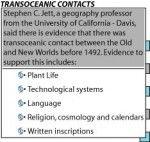There is evidence that contact between people of the Old and New Worlds occurred across oceans prior to Christopher Columbus’ travels, said professor Stephen C. Jett Friday at Texas A&M at the Oceanography and Meteorology building.
“Not only did pre-1492 contacts across oceans take place, they began early and were numerous and highly influential,” said Jett, a professor emeritus of Geography from the University of California, Davis. “Therefore, any general theory that rests on the supposition that the civilizations of the Western Hemisphere evolved in splendid isolation must be in serious error.”
Jett, a diffusionist scholar who believes that people are more plagiarizers than inventers of new components of culture, said cultures are the product of foreign influences rather than independent innovative processes.
Diffusionist scholars have been impressed by a variety of specific culture traits and complexes shared by certain societies on the two sides of the oceans, but absent in the northern areas from which ice-age humans are supposed to have migrated from Eurasia to America, Jett said.
Jett’s lecture was the first George F. Carter Lecture in a Professor Emeriti Colloquium. Carter was a distinguished professor and professor emeritus of Texas A&M’s Department of Geography before his death in March.
“There has been renewed interest (in Carter’s work) because archeologists have been finding out that man has been in America longer than originally thought,” Professor Emeritus in Geography at Texas A&M Clarissa T. Kimber said.
Jett said he attributes these contacts to characteristics that “seem particularly unlikely to have been invented more than once, especially in combination with each other.”
Such characteristics include language, written inscription, cosmology, religion and the calendar in areas in Asia and Mesoamerica, Jett said.
Jett said art styles are similar, especially those of the Eastern Zhou-Chin style of Bronze Age China and the Tajin style of late pre-Columbian Veracruz.
“(Technological systems) shared between the two hemispheres are so complex it is surprising that they ever came into being; it would be more than doubly surprising to discover that they arose a second time,” Jett said.
Such technological systems include bark cloth, paper manufacturing, blowguns, advanced metallurgy, weaving and dyeing, Jett said.
“Indications began to crop up that several cultivated plants had been shared between the hemispheres before 1492,” Jett said.
Jett said anthropologist John L. Sorenson found conclusive evidence that nearly 100 species of plants were present in Eastern and Western hemispheres prior to Columbus’ first voyage to the Americas.
Geography graduate student Jeremiah Wagstaff said agriculture was compelling evidence for transoceanic contact because, “there is only one origin for every domesticated plant and certain plants were found on both sides of the ocean, so there must have been an origin on one side and it spread from there.”
Wagstaff said that although Jett’s lecture showed there was a pattern of culture that needed to be explained, another possibility to similarities between Asia and the Americas was the colonization theory.
The colonization theory says when the Bering Strait was crossed, the coast was colonized faster than the interior, so there was colonization down to South America and that accounts for some culture similarities, Wagstaff said.
Jett said specialists believe that watercraft were capable of crossing oceans prior to 1492.
“With what we now know of early watercraft, it would not only be surprising if multiple contacts took place, it would be astonishing if such contacts did not occur,” Jett said.
Prof cites evidence of early contact across ocean
November 22, 2004

Donate to The Battalion
Your donation will support the student journalists of Texas A&M University - College Station. Your contribution will allow us to purchase equipment and cover our annual website hosting costs.



















